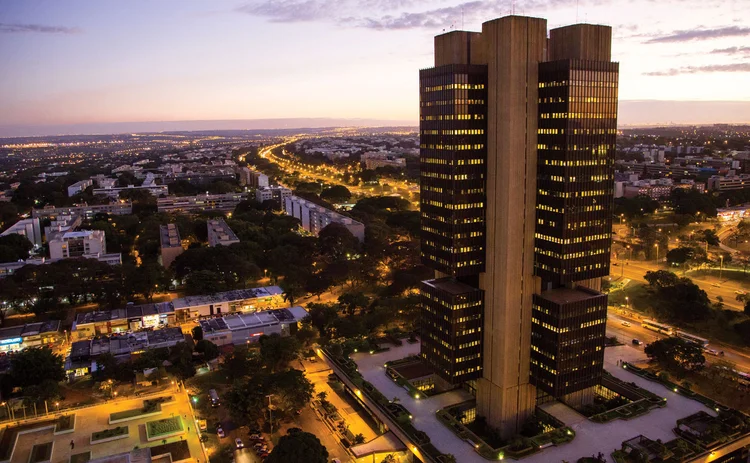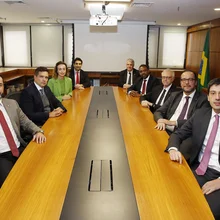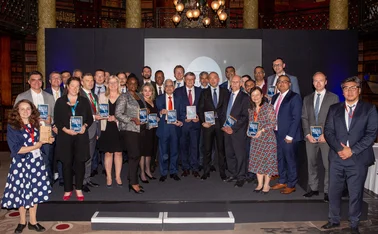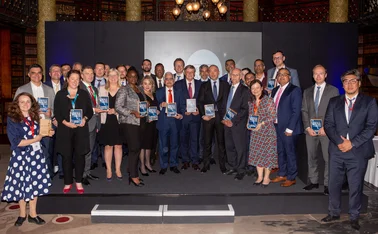
Central bank of the year: Central Bank of Brazil
The Latam central bank has pursued its mandate in an exemplary fashion, despite external pressures

In February 2021, after 30 years of debate, Complementary Law No 179 took effect. It granted “technical and operational autonomy” to the Central Bank of Brazil. The law, giving the BCB de jure autonomy, built upon the 1988 Article 164 of the Constitution that gave the BCB sole ability to issue Brazil’s official currency and prohibited it from financing the Treasury or extending loans to non-financial institutions, alongside rule changes in 1999 that heralded the introduction of inflation targeting and a flexible exchange rate.
The BCB now had autonomous authority to ensure the stability of the currency’s purchasing power, to foster a sound, efficient and competitive financial system, and to promote the economic wellbeing of society.
The legal protections for the BCB emerged following Brazil’s previously turbulent economic history, characterised by multiple fights against very high levels of inflation. An element of the legal autonomy was that while the BCB’s president and its eight directors are appointed by country’s president (and confirmed by its Senate), they would serve staggered, four-year terms with the possibility of being reappointed.
This new-found independence, however, faced a test in the lead-up the Brazilian elections that intensified following the confirmation of Luis Inácio ‘Lula’ da Silva as president over incumbent Jair Bolsonaro. Lula criticised central bank policy, claiming high interest rates were hurting the Brazilian economy.

Despite this backdrop, the BCB has striven to fulfil its inflation targeting duties while also modernising the country’s financial system. It has improved the central bank’s transparency and communications, reformed its approaches to foreign exchange interventions and supported financial stability. It has digitally transformed its own processes, burnished its environmental and financial inclusion credentials, while also upgrading its world-leading instant payments ecosystem, including efforts to incorporate a ‘digital real’ into its architectural framework. Much of this work was carried out under the BCB’s Agenda BC# structural reforms.
Autonomy and inflation targeting
Operational autonomy for the BCB came at an important time. Notably, it reduced concerns about the potential for monetary financing when, during the Covid-19 pandemic, the central bank was permitted to conduct operations in domestic secondary markets for government bonds and private assets as well as perform operations in the international market for government bonds. Signalling that the central bank had the authority and ability to take action “had an immediate impact on market prices and liquidity, reducing the need for the central bank to intervene”, according to a Bank for International Settlements working paper.
Not long after this – as elsewhere in the world – Brazil started to experience a significant jump in inflation. Unlike most of its central bank peers, the BCB’s Monetary Policy Committee (Copom) took rapid action. Between March 2021, when it began increasing its Selic rate, and September 2022, when it first held rates, the central bank increased its main policy interest rate from 2% to 13.75%.
The BCB faced a range of issues in driving inflation down. But its tightening approach finally appeared to have paid off with inflation peaking at 12.13% in April in 2022 and falling to 3.16% in June 2023
Research by Steve Kamin, Central Banking contributing editor and former director of the US Federal Reserve’s division of international finance, found the BCB, along with the Central Bank of Chile, raised rates higher, based on a cross-sectional Taylor rule, more than any other central bank in a sample of major advanced and emerging economy central banks.
Unlike its advanced economy peers, which had striven to address too-low inflation in recent years and viewed the inflationary episode in the beginning as a transitory event with supply origins, Brazil, among other emerging market economies (EMEs), saw the inflationary process as a more persistent event, with an important demand component.
The history of high inflation in Brazil was another factor that helps explain the BCB’s proactive reaction of monetary policy to face inflation ahead most advanced economy central banks. Central bankers usually try to avoid committing two types of errors. First, ‘doing too little’: being behind the curve, postponing a monetary policy tightening and tolerating more inflation, to avoid a slowdown in economic activity. Second, ‘doing too much’: being ahead of the curve, tightening monetary policy more quickly and strongly to prevent higher inflation and the de-anchoring of inflation expectations, at the expense of a sharper slowdown in economic activity.
Central banks in EMEs, with their history of higher inflation, tend to be more reactive in monetary policy tightening, hence more prone to commit the second type of error. In other words, the cost to commit the second type of error (doing too much) is lower than the first type of error (doing too little), especially in the case of EMEs with a higher inflation history.
Despite the sharp rate rises, which required some FX interventions in December 2021, as the real appreciated against the US dollar, there was no obvious strain on Brazilian financial institutions. This stability endured even when the US Fed started to increase the Fed funds rate in 2022 (prompting more BCB FX interventions in September 2022).
The BCB faced a range of issues in driving inflation down. But its tightening approach finally appeared to have paid off with inflation peaking at 12.13% in April in 2022 (12-months accumulated rate) and falling to 3.16% in June 2023 (although it had risen to 4.51% by January 2024). While the fall in inflation was not all due to tight monetary policy – the Bolsonaro government had also cut taxes on energy in the run-up to the election – it took place without tipping the economy into a downturn.

Although the BCB has drawn widespread praise for its strong commitment to combatting inflation, it attracted a sharply contrasting response from the country’s new president.
At the time, the BCB’s inflation target was set at 3.25% for 2023 and 3% in 2024 and 2025 (all ± 1.5 percentage points). While headline inflation had fallen, the BCB was aware that core inflation remained elevated, and a planned public spending framework would not contribute to lower inflation. As a result, the central bank maintained monetary policy at contractionary levels.
In Brazil’s June 2023 article IV consultation, International Monetary Fund directors “commended the central bank’s proactive monetary policy response”, saying it was “consistent” with its “inflation targeting framework”.
The report added: “Noting the slow decline in core inflation and still above-target inflation expectations, [the directors] considered the current monetary stance appropriate, and called for continued forward-looking and data-dependent monetary policy.”
For his part, Lula, who did not believe the BCB was not doing enough to support the economy, called for a change in the inflation target, saying it was too low for a middle-income economy such as Brazil. Ultimately, however, when given the chance to change the target in June, Brazil’s National Monetary Council – which included the new administration’s finance minister Fernando Haddad and planning minister Simone Tebet, alongside BCB governor Roberto Campos Neto – opted for a continuous inflation target of 3%, ± 1.5 percentage points.
By August 2023, the BCB finally believed inflation was under sufficient control – it fell below 3.2% in June, slightly below the 3.25% target for 2023 – to allow it to cut the Selic rate. The BCB decided, “considering the evolution of the disinflationary process, the assessed scenarios, the balance of risks and the broad array of available information”, to cut its policy rate to 12.75%. Copom members signalled that more 0.50 percentage point cuts were to come, and followed this up by cutting rates to 11.25%.
Speaking about the BCB’s monetary policy actions in 2023, Kamin tells Central Banking: “It has resisted calls by the government (Lula) to loosen prematurely, thereby supporting central bank independence. Second, once it decided the time was right, it has been as proactive in cutting rates as it had been in raising them, being the first, along with Chile, to do so. That also speaks well of its decision-making.”
Commitment to transparency
The BCB has also evolved its communications with different audiences when addressing issues such as monetary policy, instant payments, central bank digital currency (CBDC) and financial education. It does this as it believes straightforward and accessible communications improve the central bank’s credibility, helping it to manage expectations, while improving confidence in the financial system and in the central bank.
The BCB already has direct contact with Brazilian citizens via seven social networks – X/Twitter, LinkedIn, Facebook, Instagram, YouTube, TikTok and Threads. It has a total of 1.8 million followers. It added to this in June 2023 by producing an on-air broadcast, LiveBC, released every Monday at 2pm (local time) on the central bank’s YouTube channel. Each episode covers a new topic through a conversation between a BCB senior expert – including deputy governors – and a member of the communications team.
The broadcast lasts 30 minutes, covering the day’s main topics, issues currently reverberating on social media and in the press, and addressing questions posed by the viewers, some of which are answered in real time and on sensitive topics. In its first 17 episodes, the webcasts achieved 180,000 impressions, 35,000 views, and reached more than 52,000 people.
Digital transformation
In recent years, the BCB has extensively leveraged technological innovations to deliver benefits to the Brazilian population. This has involved developing significant in-house technology as well as internal organisational process changes to ensure both internal and external digital transformation.
The most obvious example is the development of the Pix retail instant payment system, launched in November 2020. Pix’s creation has resulted in more than 70 million Brazilian citizens conducting bank transfers for the first time. The BCB estimates that Pix has generated net benefits of $5.7 billion for citizens and businesses. It also played a major role in Brazil climbing 17 places to 21st in the Global Financial Inclusion Index. Meanwhile, ATM and bank branch withdrawals have fallen from 3.4 billion in 2020 to 2.6 billion in 2022, according to the BCB.
The BCB is demonstrating that digital transformation will make the Brazilian financial system increasingly inclusive
The Brazilian central bank made the code to Pix ‘open source’, so other central banks can use the coding and is seeking to integrate its work on a digital real into the scheme.
The BCB has also been moving towards issuing a CBDC. The ‘drex’ is the Brazilian real in a digital format, to be issued exclusively on a digital platform operated by the BCB.
In practice, the Drex Platform is a distributed ledger technology (DLT) ecosystem, in which regulated financial intermediaries will convert balances of demand deposits and electronic money in drex, so their clients have access to a wide provision of financial products or services, including Pix.
Meanwhile, the BCB has also harnessed technology to establish an ‘amounts receivable information system’ (SVR), which allows citizens to check if they have unclaimed assets held in banks and other authorised institutions. When a positive match is made, users can request the redemption of these assets through Pix or determine how to contact the institution for reimbursement. To get SVR working meant regulated financial institutions had to consolidate all unclaimed assets in one centralised location, an authentication link with the government’s digital identity platform, a hook-up to Pix and use of a cloud-based system that could handle 300,000 simultaneous users at launch.
So far, SVR has processed 114 million checks, with around 50% indicating users have assets to claim. This has resulted in the return of approximately 3 billion real ($607,900) to 13.8 million individuals, 1 billion real to nearly 500,000 legal entities, and the availability of over 7 billion real for redemption by roughly 36 million individuals and 3 million legal entities.
The BCB is demonstrating that digital transformation will make the Brazilian financial system increasingly inclusive.

Climate commitment
The BCB has long taken actions related to the climate, aware of the risks that environmental destruction pose to its economy. In 2020, sustainability became one of the six pillars of the BCB’s strategic agenda, Agenda BC#. This resulted in the BCB aiming to promote the development of sustainable finances in the national financial system, ensuring greater availability of financial resources for sustainability, and better management of social, environmental and climate risks in line with international best practices.
Internally, the institution is integrating sustainable variables into its decision-making process. Its sustainable economy committee (Ecos) and Sustainability and International Portfolio Investors Unit (Gerip) support the BCB’s deputy governor for international affairs and corporate risks in these developments. Meanwhile, the social and environmental responsibility committee (CRSO) focuses on reducing the impact of the BCB activities.
Sustainable initiatives include: sustainability criteria on rural credit; socio-environmental responsibility and risk management policies for financial institutions; studies to estimate the exposure of the national financial system to physical and transitional climate risks, including greenhouse gas emissions, and sensitivity analysis of extreme droughts and intense floods scenarios; the introduction of sustainability criteria on international reserve management; and BCB carbon footprint reduction practices.
Among the initiatives, the Sustainable Rural Credit Bureau stands out, contributing to mitigate illegal land use practices, through georeferenced co-ordinates, with indirect impacts on deforestation and biodiversity preservation.
By making it easier to identify rural credit operations that have social or environmental benefits, the financial system should offer more favourable conditions to producers with sustainable characteristics. Moreover, using data from the Sustainable Credit Rural Bureau, financial institutions should more strongly mitigate the risk of granting credit for operations with higher social or environmental risk.
These efforts are subject to continuous refinements. As a recent example, in 2023, CMN Resolution No 5,081 forbade the granting of credit to properties with suspended or cancelled Rural Environmental Registries and extended to all biomes the restrictions that were previously applied only to the Amazon.
Overall, the results of Brazil’s experiment with central bank autonomy – to avoid excessively high interest rates needed to tackle major inflation episodes that have restrained human and physical capital investment – are not yet conclusive. But the new safeguards have ensured greater consistency in policy during a transition of government, as well as time for a full exchange of knowledge-sharing among central bank officials and economic agents of the new government. Meanwhile, inflation is under greater control than in many advanced economics.
The Central Banking Awards 2024 were written by Christopher Jeffery, Daniel Hinge, Dan Hardie, Joasia Popowicz, Ben Margulies, Riley Steward, Jimmy Choi and Blake Evans-Pritchard.
Only users who have a paid subscription or are part of a corporate subscription are able to print or copy content.
To access these options, along with all other subscription benefits, please contact info@centralbanking.com or view our subscription options here: http://subscriptions.centralbanking.com/subscribe
You are currently unable to print this content. Please contact info@centralbanking.com to find out more.
You are currently unable to copy this content. Please contact info@centralbanking.com to find out more.
Copyright Infopro Digital Limited. All rights reserved.
You may share this content using our article tools. Printing this content is for the sole use of the Authorised User (named subscriber), as outlined in our terms and conditions - https://www.infopro-insight.com/terms-conditions/insight-subscriptions/
If you would like to purchase additional rights please email info@centralbanking.com
Copyright Infopro Digital Limited. All rights reserved.
You may share this content using our article tools. Copying this content is for the sole use of the Authorised User (named subscriber), as outlined in our terms and conditions - https://www.infopro-insight.com/terms-conditions/insight-subscriptions/
If you would like to purchase additional rights please email info@centralbanking.com
Most read
- ECB says iPhone is currently incompatible with digital euro
- Supervisors grapple with the smaller bank dilemma
- ‘Do I die, or do I survive?’ Officials reflect on Basel III complexity






